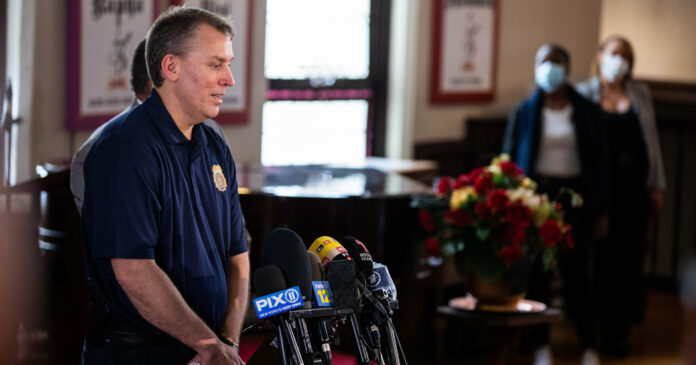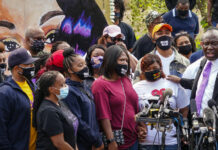The commissioner is reassigning about 600 officers from teams that target violent crime. He called it a “seismic shift” in police culture.

The New York police commissioner announced on Monday that he was disbanding the Police Department’s anti-crime units: plainclothes teams that target violent crime and have been involved in some of the city’s most notorious police shootings.
Roughly 600 officers serve in the units, which are spread out across the city and work out of the department’s 77 precincts and nine housing commands. They will immediately be reassigned to other duties, including the detective bureau and the department’s neighborhood policing initiative, the commissioner, Dermot F. Shea, said.
Mr. Shea said the plainclothes units were part of an outdated policing model that too often seemed to pit officers against the communities they served, and that they were involved in a disproportionate number of civilian complaints and fatal shootings by the police. He said the department now depends much more on intelligence gathering and technology to fight crime and “can move away from brute force.”
“This is a seismic shift in the culture of how the N.Y.P.D. polices this great city,” Mr. Shea said. “It will be felt immediately in the communities that we protect.”
The unexpected announcement came after weeks of protests and public unrest over police brutality after the death in Minneapolis of George Floyd, a black man who was killed when a white police officer knelt on his neck for nearly nine minutes.
Within the department, the anti-crime units were seen as an elite force aimed at disarming criminals in the city’s most violent pockets. Created with the mission of ridding the street of illegal guns and stopping violent crimes, the units were widely seen as a steppingstone for ambitious officers who hoped to join the Detective Bureau.
But for critics of the department, the anti-crime units have become a symbol of the aggressive policing strategies that are now being called into question by the protest movement. Not all are being disbanded: Those that work in the city’s transit system will remain in their role, Mr. Shea said, and plainclothes units will continue to operate in other divisions of the police department.
Mr. Shea said Monday that the anti-crime units were a vestige of the city’s era of “stop-and-frisk,” when officers routinely searched people in high-crime areas, a practice that a judge declared unconstitutional after finding it disproportionately affected people of color.
“This is 21st-century policing,” Mr. Shea said of his decision to disband the units. “The key difference — we must do it in a manner that builds trust between the officers and the community they serve.”
The anti-crime units have been routinely touted by the department’s leaders as a key tool to fight crime in some of the city’s most dangerous neighborhoods. They have been credited with taking thousands of illegal guns off city streets.
The officers in the units took on their own roguish image: The assignment was seen as dangerous, reserved for the tough and the brash, the pinnacle of good-guy-gets-the-bad-guy policing. Among the rank-and-file, the abolishment of the plainclothes units is likely to be seen as a retreat from traditional police work.
“Anti-crime’s mission was to protect New Yorkers by proactively preventing crime, especially gun violence,” said Patrick J. Lynch, the president of the Police Benevolent Association, the city’s largest police union. “Shooting and murders are both climbing steadily upward, but our city leaders have clearly decided that proactive policing isn’t a priority anymore.”
But among experts on policing, Mr. Shea’s announcement was seen as an enterprising response to mounting pressure to overhaul how the department operates within the city.
“It’s really sending the message that we have to work on trust building. You can reduce crime, but if the public still feels that they don’t trust the police, then you’ve lost the moral high ground,” said Chuck Wexler, executive director of the Police Executive Research Forum, a law enforcement policy nonprofit. “Police departments across the country will see this as a wake- up call.”
Public defenders and civil rights lawyers viewed the move with wary optimism, saying they could not be sure if it would turn out to be cosmetic or a lasting change.
Darius Charney, a staff lawyer with the Center for Constitutional Rights, a civil rights group, said that the decision to disband the anti-crime teams seemed sudden and rushed. He also noted that Mr. Shea did not mention the borough-based anti-crime teams that were “some of the worst” offenders at the height of stop-and-frisk.
“For this change to have any meaningful impact on how communities experience policing in N.Y.C., these former anti-crime officers will need to change the way they police communities of color, and nothing the commissioner said gives me any confidence that the N.Y.P.D. has a plan to make sure that happens,” Mr. Charney said.
Mr. Charney noted the city had embarked on a similar mission in 2002, when it disbanded its plainclothes Street Crime Unit. “The problem got much worse over the next 10 years,” he said.
The anti-crime units had absorbed the remnants of the city’s plainclothes Street Crime Unit, which had begun three decades earlier.
The Street Crime Unit was disbanded by Commissioner Raymond W. Kelly after years of simmering criticism over the 1999 shooting of Amadou Diallo. Plainclothes officers had shot Mr. Diallo, a street vendor, 41 times after mistaking his wallet for a gun. Mr. Kelly reassigned the remaining Street Crime officers to various anti-crime units across the city.
Though the anti-crime officers account for only about 2 percent of the department’s uniformed force, they have been involved in a disproportionate number of shootings by the police.
A 2018 review of fatal police shootings in New York City conducted by The Intercept, an online publication, found that plainclothes anti-crime officers had been involved in 31 percent of the incidents since 2000.
In 2018, anti-crime officers shot and killed Saheed Vassell, a mentally ill man who pointed a metal pipe toward them like a gun on a busy Brooklyn street. Mr. Vassell, 34, was known as an idiosyncratic fixture in the neighborhood, and patrol officers were familiar with the man’s bizarre antics. The anti-crime officers who responded however, were part of a team that did not routinely work in the area and did not know Mr. Vassell.
Last September, an anti-crime unit officer, Brian Mulkeen, was shot and killed by his partners in the Bronx while he struggled on the ground with Antonio Lavance Williams. Mr. Williams was also killed in a police fusillade. The police said Mr. Williams was found to be carrying an illegal gun, but it remains unclear why Officer Mulkeen and his partners tried to stop and question him in the first place.
Mayor Bill de Blasio and Mr. Shea also have come under pressure from protesters and elected officials to reduce the size of the police department and shift resources into social programs. The City Council speaker, Corey Johnson, has proposed slashing the Police Department’s $6 billion budget by $1 billion.
Ashley Southall contributed reporting.







